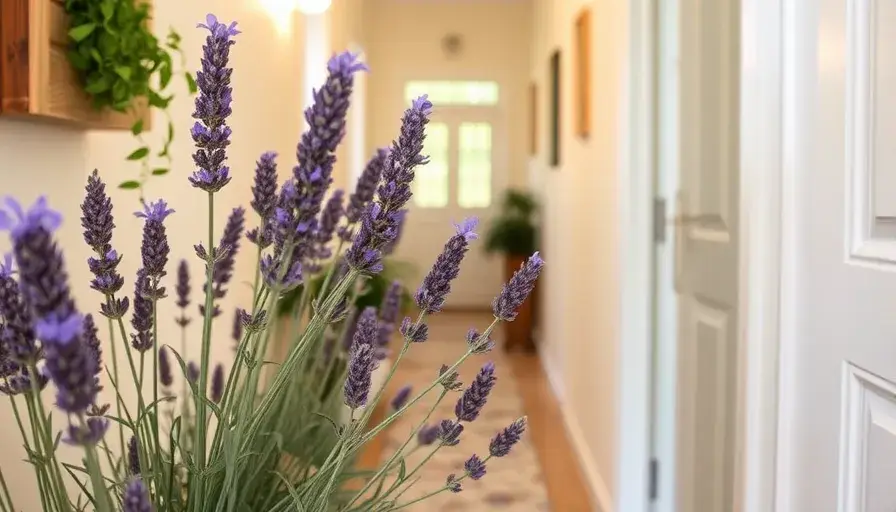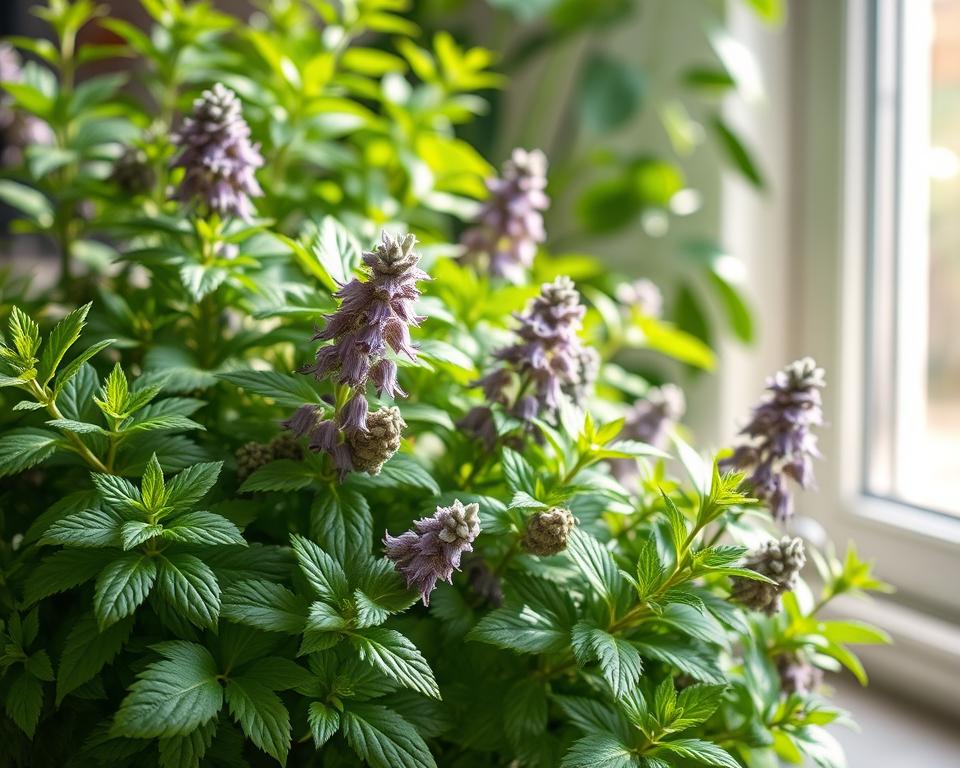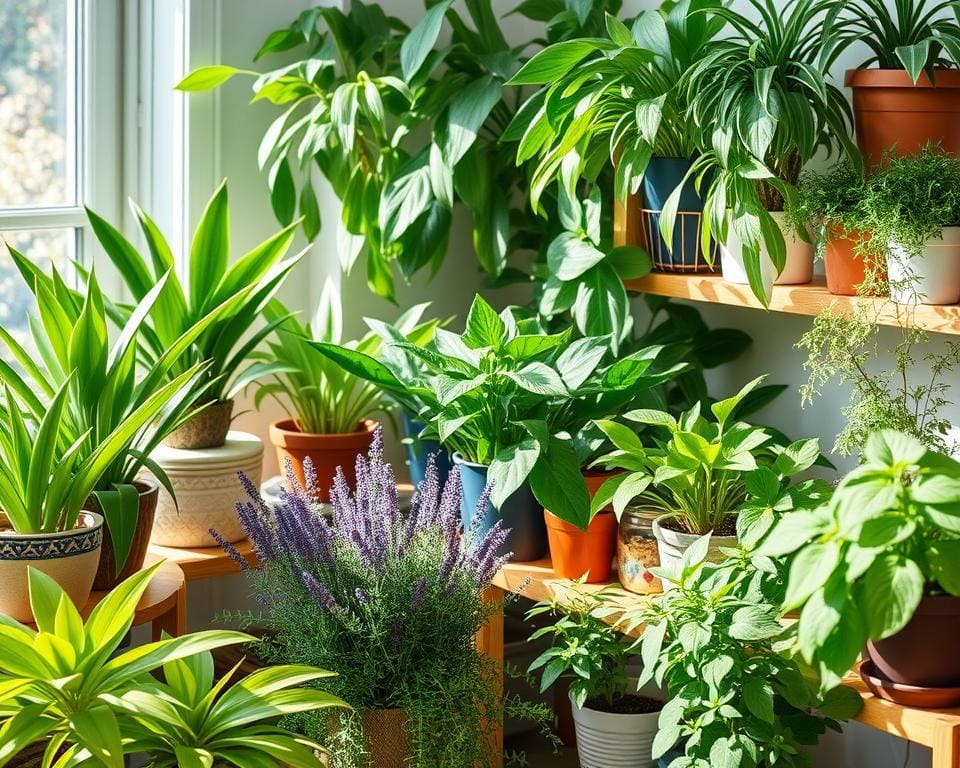Are you tired of dealing with pesky insects in your home? What if you could keep them away with a few houseplants? These plants can help control pests like flies, mosquitoes, cockroaches, and ants naturally.
We’ll look at different houseplants that keep your home bug-free and nice-looking. While you should use professional pest services too, these plants add a natural defense against pests.
Key Takeaways
- Certain indoor plants can effectively deter common household pests like flies, mosquitoes, cockroaches, and ants.
- These pest-repelling houseplants include herbs, flowers, and even carnivorous varieties.
- The plants’ natural oils and scents are often unpleasant for insects, making them a safe and eco-friendly solution.
- Combining plants with professional pest management services can provide a comprehensive approach to keeping your home pest-free.
- Choosing the right pest-repelling plants for your indoor space can be a game-changer in your battle against unwanted bugs.
Introduction to Pest-Repelling Indoor Plants
Adding pest-repelling plants to your home is a natural way to keep pests away. These plants have strong smells, oils, and toxins that insects dislike. This helps you avoid using harsh chemicals, offering benefits of pest-repelling plants and advantages of natural pest control.
Why Use Plants to Deter Pests?
Choosing indoor plants for insect management is a wise decision for those wanting houseplants as eco-friendly pest deterrents. Plants like snake plants, Chinese evergreens, and cast iron plants are tough against pests. They’re perfect for keeping your home bug-free. Plus, they clean the air, making your home healthier.
Overview of Common Household Pests
Common bugs found in homes that houseplants can keep away include mosquitoes, flies, cockroaches, ants, fleas, and bed bugs. These household pest identification pests can be a real problem. But, with the right plants, you can stop them without using harsh chemicals.
By using benefits of pest-repelling plants in your home, you can live in a bug-free space. This makes your home healthier and more sustainable.
Basil and Mint: Fragrant Herb Deterrents
Basil and mint are great for keeping pests away. They have strong scents that insects like flies and mosquitoes don’t like. Growing these herbs in your kitchen or near doors can help keep bugs away naturally.
Basil has leaves that smell great and keep mosquitoes away. Mint is also good at keeping many insects away because of its scent. These herbs have been used for pest control for a long time. They are easy to grow and a good way to keep bugs away without chemicals.
“Basil and mint are two of the most effective natural pest deterrents you can grow at home. Their strong scents confuse and deter a variety of insects, providing a chemical-free way to protect your living space.”
These herbs are great for fighting off flies, mosquitoes, and fruit flies. Adding basil and mint to your indoor garden can really help. They make your space smell fresh and help keep it free of pests.
Using basil and mint can make your home a bug-free haven. These herbs naturally keep insects away. Enjoy a clean and pleasant living space with the help of these versatile herbs.
Sage and Rosemary: Zesty Herb Repellents
Sage and rosemary are not just tasty herbs but also strong bug deterrents. Burning their dried leaves sends out smoke that keeps mosquitoes and flies away. You can also put dried sage and rosemary in drawers and closets to ward off silverfish, moths, and other pests. These herbs have a strong, zesty smell that bugs don’t like.
Using Dried Herbs for Pest Control
Dried herbs are a great, natural way to fight off household pests. Besides sage and rosemary, herbs like lavender, thyme, and bay leaves also work well. Put sachets of these herbs in closets, drawers, and other places where pests might hide.
You can also make your own natural pest-repelling sprays with dried herbs and essential oils. Soak the herbs in water, strain it, and mix in a few drops of oils like peppermint, lemongrass, or citronella. This spray can help keep insects away from your home.
“The strong, earthy scent of sage and the refreshing aroma of rosemary work wonders in keeping common household pests at bay.”
Using zesty, aromatic herbs like sage and rosemary is a great way to keep pests away without chemicals. Whether you burn them, dry them, or make sprays, sage and rosemary are great at keeping insects away.
Citronella Plant and Lemongrass: Citrus Scents to Repel Mosquitoes
Mosquitoes can be a big problem, but nature has natural ways to fight them. The citronella plant and lemongrass are great for keeping mosquitoes away. They have a strong citrus smell thanks to citronella oil. This smell is great at keeping mosquitoes and other bugs away.
By growing citronella plants or lemongrass in pots outside, you can make a mosquito-free area. You can also rub the leaves on your skin for extra protection. The smell of citronella and lemongrass is nice and keeps pests away.
| Plant | Key Benefit | Suitable Zones |
|---|---|---|
| Citronella Plant | Mosquito Repellent | Zones 9-11 |
| Lemongrass | Natural Bug Deterrent | Zones 9-11 |
If you want to keep mosquitoes away from your outdoor fun or make your home smell nice, think about citronella plants and lemongrass. These plants have a strong citrus smell that mosquitoes don’t like. This makes your living space refreshing and free from pests.

“Citronella oil sourced from the lemongrass plant is commonly used in bug sprays and candles for mosquito repellent.”
Marigolds: Bright Blooms, Strong Odor
Marigolds are bright and versatile flowers with a strong smell that many insects dislike. They belong to the aster family and come in types like African, French, and Signet marigolds. Their smell makes them great for using flowers to deter insects and marigolds as natural pest control in your home and garden.
The colorful plants that repel bugs like marigolds keep away flies, gnats, mosquitoes, and midges. If you’re growing marigolds indoors and outdoors for pest management, they offer beautiful flowers and pest control.
French Marigolds grow 6-12 inches tall and have flowers that are 1-2 inches wide. They come in yellow, orange, red, and bicolor. African Marigolds can grow up to 4 feet tall and have big flowers in yellow, orange, and white.
Signet Marigolds are smaller, growing 12-20 inches tall with smaller flowers. They have a citrusy scent and come in yellow, orange, golden, and bicolor. Marigolds have been used for over 2,000 years in Mexico and Central America. They are a beloved and practical addition to gardens worldwide.
Research shows marigolds can control pests like nematodes, but their effectiveness is still being studied. Some marigolds, like “Single Gold” Tagetes patula, are better at controlling nematodes. Marigolds also attract beneficial insects like hover flies, ladybugs, and parasitic wasps, which help control other pests.
If you want to deter insects with colorful plants or use marigolds as natural pest control, consider these bright, fragrant flowers. They are adaptable, easy to care for, and can help keep pests away. They are a valuable addition to any garden or home.
Lavender: Elegant Looks, Potent Pest Deterrent
Lavender is more than just a pretty herb; it’s a strong natural pest repellent. For over 2,500 years, people have used it for its healing properties. Its strong smell keeps many common household pests away.
English Lavender (Lavandula angustifolia) and French Lavender (Lavandula stoechas) are top choices for fighting pests. Their scents keep away aphids, mosquitoes, and moths. You can grow lavender in pots or use dried sachets to keep pests away.
Pruning lavender once a year, in early spring or late fall, keeps it healthy and effective against pests. You can also use lavender essential oil safely on your skin to repel insects. Mixing lavender with herbs like rosemary, sage, and thyme creates a pest-free garden.
As fall comes, homes may attract more flies. Luckily, lavender is one plant that can keep them away. Other plants like basil, mint, and rosemary also help repel flies.
Lavender isn’t just for flies; it also keeps beetles and fleas away. This makes it a great choice for anyone looking to control pests naturally. With lavender, you can enjoy its beauty and keep pests away.
Indoor Plants That Repel Common Household Pests
There are many indoor plants that can keep common household pests away. These varieties of pest-repelling houseplants include aglaonemas, bromeliads, cast iron plants, cissus, coleus, dracaenas, and jade plants. They have tough leaves or produce oils that bugs don’t like. Putting these plants around your home can act as a natural barrier against pests.
Aglaonemas, or Chinese evergreens, keep aphids and spider mites away. Bromeliads trap water and debris, making them hard for pests to live in. Cast iron plants resist scale insects and mealybugs with their tough leaves.
Cissus, or grape ivy, has sap that keeps insects away. Coleus plants have an aroma that bugs don’t like. Dracaenas and jade plants are also good at keeping pests away.
| Plant | Pests Repelled |
|---|---|
| Aglaonema | Aphids, Spider Mites |
| Bromeliad | Various Insects |
| Cast Iron Plant | Scale Insects, Mealybugs |
| Cissus | Insects |
| Coleus | Various Bugs |
| Dracaena | Thrips, Spider Mites |
| Jade Plant | Common Indoor Pests |
Using a mix of best indoor plants for natural pest control can make your home pest-free. This way, you can enjoy a healthy living space without pests.
Catnip: Feline Favorite, Insect Repellent
Catnip is a favorite among cats and also a great tool for natural pest control. It’s a simple plant that can help keep pests away from your home. This makes it perfect for those who prefer eco-friendly solutions.
Using Catnip as a Natural Spray
The key to catnip’s bug-fighting power is its nepetalactone oil. This oil is great at keeping cockroaches and mosquitoes away. You can make a bug spray at home by boiling catnip leaves in water.
This spray is safe and doesn’t have harsh chemicals. You can spray it around your house to keep pests away.
Catnip loves well-drained soil and lots of sunlight. It’s perfect for indoor pest control. You can trim its leaves and put them in areas you want to protect. Or, make a catnip sachet for your drawers and closets.

Using catnip for pest control is easy and effective. It’s a tough plant that grows well indoors or outside. It keeps pests away and is safe for your family and pets.
Chrysanthemums: Colorful Flowers, Powerful Protection
Chrysanthemums are more than just pretty flowers. They are a strong natural bug repellent. These plants have pyrethrum, a substance that bugs like ants, ticks, and fleas can’t stand. You can grow them inside or outside to keep pests away.
These flowers are perfect for those who want to fight pests naturally without losing style. They come in many colors, like white, yellow, red, and purple. So, you can decorate your home and keep bugs away at the same time.
For centuries, people have used chrysanthemums to fight off insects. They are still the top choice for home bug control. The pyrethrins from these flowers are used in many bug sprays. Studies prove they work against many pests, like beetles, fleas, and roaches.
Chrysanthemums are safe for birds, mammals, and people, unlike many chemical sprays. This makes them a better choice for keeping your home bug-free. So, adding some chrysanthemums to your plants can help you live bug-free.
Carnivorous Plants: Nature’s Pest Traps
For a unique way to fight pests, think about adding carnivorous plants to your indoor garden. These plants eat insects, making them great for pest control.
The Venus Flytrap and Other Carnivorous Varieties
The Venus flytrap is well-known for catching flies and gnats with its leaves. It can digest a bug in 3 to 12 days. Other plants like pitcher plants and sundews also help control pests at home.
While you might need many to tackle big pest problems, these plants are a great addition. The Venus flytrap is a top choice. But, don’t forget about other carnivorous plants that fight household pests.
| Carnivorous Plant Variety | Prey Attraction | Growing Conditions |
|---|---|---|
| Sundews | Traps insects in sticky hairs on leaves | Easy to grow indoors |
| Butterworts | Trap insects in adult/flying stages | Perennial plants |
| Bladderworts | Efficient at capturing underground insects | Challenging for indoor growth |
| Pitcher Plants (Sarracenia) | Attract larger prey like wasps and flies | Prefer full sun exposure outdoors |
| Tropical Pitcher Plants (Nepenthes) | Attract diverse prey | Require shadier conditions, cool temps, and high humidity |
Choosing the Venus flytrap or other carnivorous plants can be an interesting and effective way to keep pests away indoors.
Culinary Herbs: Flavorful and Pest-Resistant
Many common culinary herbs are great at keeping pests away naturally. These plants add flavor to your cooking and help keep insects away from your home. By growing these herbs, you can make a garden that tastes great and keeps pests away.
Herbs like basil, chives, chamomile, and mint have smells and tastes that insects dislike. Their strong scents can keep flies, mosquitoes, and other pests away. For example, rosemary does well in well-drained soil and is good for Zones 7 to 10. Citronella grass is great for keeping mosquitoes away and grows in Zones 10 to 11.
These herbs are not only good at keeping pests away but are also safe to eat. Lavender has a scent that keeps mosquitoes away and grows in Zones 5 to 9. It adds a nice touch to many dishes.
- Petunias keep pests like aphids and beetles away.
- Nasturtium is safe to eat and keeps pests like whiteflies away, growing in Zones 9 to 11.
- Chrysanthemums make a natural insecticide and keep pests away, needing water when the soil is dry, in Zones 5 to 9.
- Marigold keeps pests like Mexican bean beetles away and grows well in dry conditions, in Zones 2 to 11.
Adding these herbs to your kitchen garden or around your home lets you enjoy tasty food and a natural way to keep pests away. Use culinary herbs as a smart way to fight pests.
Conclusion
Indoor plants are a great way to keep pests away without harsh chemicals. By placing different pest-repelling plants around your home, you can create a barrier against mosquitoes, flies, and cockroaches. These plants, like fragrant herbs and flowers, make your space look good and keep pests away.
Using summary of pest-repelling houseplants with other eco-friendly solutions helps keep your home bug-free without chemicals. These plants do more than just fight pests; they also improve the air quality and make your home feel more natural.
If you want a healthier, more sustainable home, try using natural methods for indoor pest control. By adding pest-repelling plants and eco-friendly options, you can have a beautiful home free of pests. This approach also helps protect the environment.
FAQ
What are the benefits of using indoor plants to deter pests?
Using indoor plants to keep pests away is a natural and eco-friendly way. Many houseplants release strong smells, oils, and toxins. These are bad for pests like mosquitoes, flies, and cockroaches. This stops infestations without harsh chemicals.
What are some of the most effective pest-repelling houseplants?
Effective houseplants for keeping pests away include basil, mint, and sage. Rosemary, citronella plant, and lemongrass also work well. Marigolds, lavender, aglaonemas, and bromeliads are good choices too. Cast iron plants, cissus, coleus, dracaenas, and jade plants are also effective.
How can I use catnip and chrysanthemums to control pests?
Catnip has an oil called nepetalactone that keeps cockroaches away. You can grow it in a pot and use its leaves to repel pests. Or, simmer the plant in water for a homemade bug spray.
Chrysanthemums have pyrethrum, a natural insecticide. It keeps ants, ticks, and other pests away. These plants are great for your home.
Can carnivorous plants like the Venus flytrap help control pests?
Yes, carnivorous plants like the Venus flytrap can control pests. They trap flies and gnats with their leaves. Pitcher plants and sundews also help keep pests away from your indoor garden.
How can I combine pest-repelling plants with other eco-friendly pest control methods?
Adding pest-deterring houseplants to your home is a great way to fight pests naturally. You can also use homemade sprays, diatomaceous earth, or physical barriers. Together, these methods create a chemical-free way to keep your home bug-free.
Sources:
Houseplants That Deter Insects







